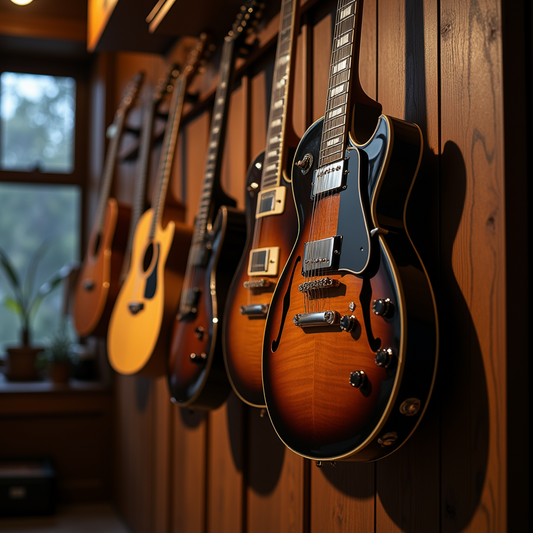How to Hold the Guitar Properly: An Introduction to Different Types and Tips
Share
Introduction
Playing the guitar is truly an art form that bestows joy and creativity upon a vast number of individuals. It's like a magical gateway that opens up a world of self - expression and musical exploration. However, before one can start creating those alluring chords and melodies that can stir the soul, it is of utmost importance to learn the correct way of holding the guitar. A proper hold is not just a matter of convenience; it is like the cornerstone upon which the entire edifice of good guitar playing is built. It significantly enhances the comfort during playing, much like a well - fitted shoe that allows one to walk for miles without discomfort. Moreover, it has a profound impact on the quality of the sound produced and the overall proficiency in playing.
Importance of Proper Guitar Holding
Comfort and Endurance
-
When you hold the guitar correctly, it's as if you've found the perfect ergonomic setup for your body. You can engage in long - duration playing sessions without succumbing to excessive fatigue or discomfort in your hands, arms, or back. This is especially crucial for those marathon practice sessions or energetic gigs. Think of it as a long - distance runner who has the right shoes and running form; they can keep going without getting overly tired. For instance, many professional guitarists who perform in concerts that last for hours have mastered the art of holding the guitar in a way that allows them to maintain their energy and focus throughout the performance. According to a study by a music ergonomics expert, improper guitar holding can lead to a 30% decrease in playing time before fatigue sets in.
Sound Production
-
The proper hold of the guitar is like a key that unlocks the full potential of sound production. It provides better access to the strings and fretboard, enabling you to coax out clear and resonant sounds. It's similar to a skilled painter having the right brushes and canvas to create a masterpiece. You can control the dynamics of your playing, from the softest and most delicate notes to the loudest and most powerful chords. Renowned guitarists often emphasize the importance of this aspect. For example, the great Andres Segovia, a master of the classical guitar, was known for his meticulous guitar - holding technique, which contributed to the rich and sonorous tones in his performances. His hold allowed him to precisely manipulate the strings, creating a sound that was both pure and evocative.
Technique Development
-
A good hold serves as the bedrock for the development of advanced guitar techniques. It's like the foundation of a building that supports the superstructure. It sets the stage for proper finger placement, strumming, and picking, which are indispensable for achieving a performance that sounds professional. Just as a ballet dancer needs a strong core and proper footwork to execute complex choreography, a guitarist needs a correct hold to perform intricate techniques. Take the example of Eddie Van Halen, whose innovative guitar - playing techniques revolutionized rock music. His unique hold of the electric guitar enabled him to execute lightning - fast runs up and down the fretboard and create his signature sounds.
Body: Different Types of Guitar Holds
1. Classical Guitar Hold
-
Seated Position: Sit on the edge of a chair with your back straight, as if you were a disciplined student in a classroom. Place your left foot on a footstool (a common practice among most classical guitarists). This is like creating a stable base for the guitar. The guitar should rest on your left thigh, with the body of the guitar slightly angled upwards, much like a precious object being presented at a slight elevation.
-
Supporting the Guitar: Use your left arm to cradle the guitar's neck, just as a mother would cradle her baby. Your left hand should be free to move along the fretboard, like a nimble explorer traversing uncharted territory. The right arm should rest comfortably on the top of the guitar, near the soundhole, for proper fingerpicking. This position is ideal for classical music as it provides the stability required for precise fingerpicking and complex chord voicings. It also promotes good posture, which is vital for long - term playing health. A study on classical guitarists showed that those who maintained this hold had fewer incidences of musculoskeletal problems compared to those with improper holds.
2. Acoustic Guitar Hold (for Folk and Strumming Styles)
-
Sitting Position: Sit upright in a chair or on a stool, exuding an air of relaxation and ease. You can cross your legs if it feels comfortable, like someone settling in for a laid - back conversation. The guitar can rest on your right thigh, with the body of the guitar more parallel to the floor compared to the classical hold. This gives a different feel and access to the strings.
-
Strumming Arm Placement: Your right arm should be relaxed and able to move freely for strumming, like a gentle breeze flowing through the trees. The elbow should be at a natural angle, not too far out or tucked in too tightly. This allows for a natural and fluid strumming motion.
-
Left - Hand Support: The left hand supports the neck of the guitar as needed for chord changes. This hold allows for a more relaxed and open - handed approach to strumming, which is great for folk, country, and pop music styles. Many folk musicians prefer this hold as it gives them the freedom to create a more laid - back and rhythmic sound. For example, Bob Dylan, with his iconic acoustic performances, likely had a hold that allowed him to strum with ease while changing chords effortlessly.
3. Electric Guitar Hold
-
Standing Position: When playing an electric guitar while standing, use a guitar strap adjusted to a comfortable length. The guitar should hang at a height where your hands can easily reach the fretboard and pickups, much like a well - placed weapon ready for action.
-
Balance and Mobility: The guitar should be balanced so that it doesn't swing too much while you play. You should be able to move around the stage freely while maintaining a good hold on the guitar. This is crucial for electric guitarists who often need to be mobile on stage. For instance, Jimi Hendrix was known for his dynamic stage presence while playing the electric guitar. His ability to move around while maintaining a proper hold on his guitar added to the energy and excitement of his performances.
-
Playing Style Considerations: For lead guitar playing, you may need to adjust the hold slightly to allow for quick runs up and down the fretboard. It's like a sprinter getting into the perfect starting position. For rhythm guitar, a more stable hold is often preferred to ensure consistent strumming, similar to a drummer keeping a steady beat.
Tips for a Proper Guitar Hold
1. Posture
-
Keep Your Back Straight: Whether sitting or standing, maintaining a straight back is essential. It's like a flagpole standing tall and proud. Slouching can lead to poor hand position and reduced playing ability. Just as a building with a crooked foundation is unstable, a slouched posture can undermine your guitar - playing skills.
-
Relax Your Shoulders: Tense shoulders can cause unnecessary strain, like a tightly coiled spring that is about to snap. Let your shoulders drop and relax to allow for smooth movement of your arms. This is similar to a well - oiled machine where all the parts move freely without friction.
2. Hand Placement
-
Left - Hand Fingering: In the left hand, each finger (index, middle, ring, and little finger) should be assigned to specific frets for efficient chord changes. For example, in basic chord shapes, the index finger often plays on the first fret, the middle finger on the second, etc. This is like a well - coordinated team where each member has a specific role to play. Just as in a basketball team where each player has a position, the fingers on the left hand have their designated areas on the fretboard.
-
Right - Hand Strumming and Picking: The right hand should hold the pick (if using one) correctly. The pick should be held between the thumb and index finger with a firm but not overly tight grip, much like holding a delicate flower without crushing it. For fingerpicking, the fingers should be positioned over the strings in a way that allows for clear and distinct plucking. This is like a skilled archer aiming for the bullseye with precision.
3. Adjusting for Comfort
-
Experiment with Different Holds: Every guitarist is different, like snowflakes that are all unique. So don't be afraid to try different ways of holding the guitar until you find what works best for you. You may need to make small adjustments based on the type of guitar you are playing (e.g., a large - bodied acoustic vs. a slim electric). It's like trying on different shoes to find the perfect fit.
-
Use Accessories if Needed: If you find it difficult to maintain a proper hold, consider using accessories such as guitar supports or ergonomic straps. These can help improve your playing comfort and stability, much like using a crutch to support a sprained ankle.
Conclusion
In conclusion, learning how to hold the guitar properly is a fundamental and indispensable step in your guitar - playing odyssey. It is like the first step on a long and rewarding journey. It affects your comfort, sound, and technique development in ways that are far - reaching. By understanding the different types of guitar holds and following the tips for proper posture and hand placement, you can pave the way for success as a guitarist. Whether you are a novice just embarking on this musical adventure or an experienced player seeking to refine your skills, taking the time to master the proper guitar hold will yield bountiful rewards in the long run. It's like investing in a high - quality tool that will serve you well for years to come.



